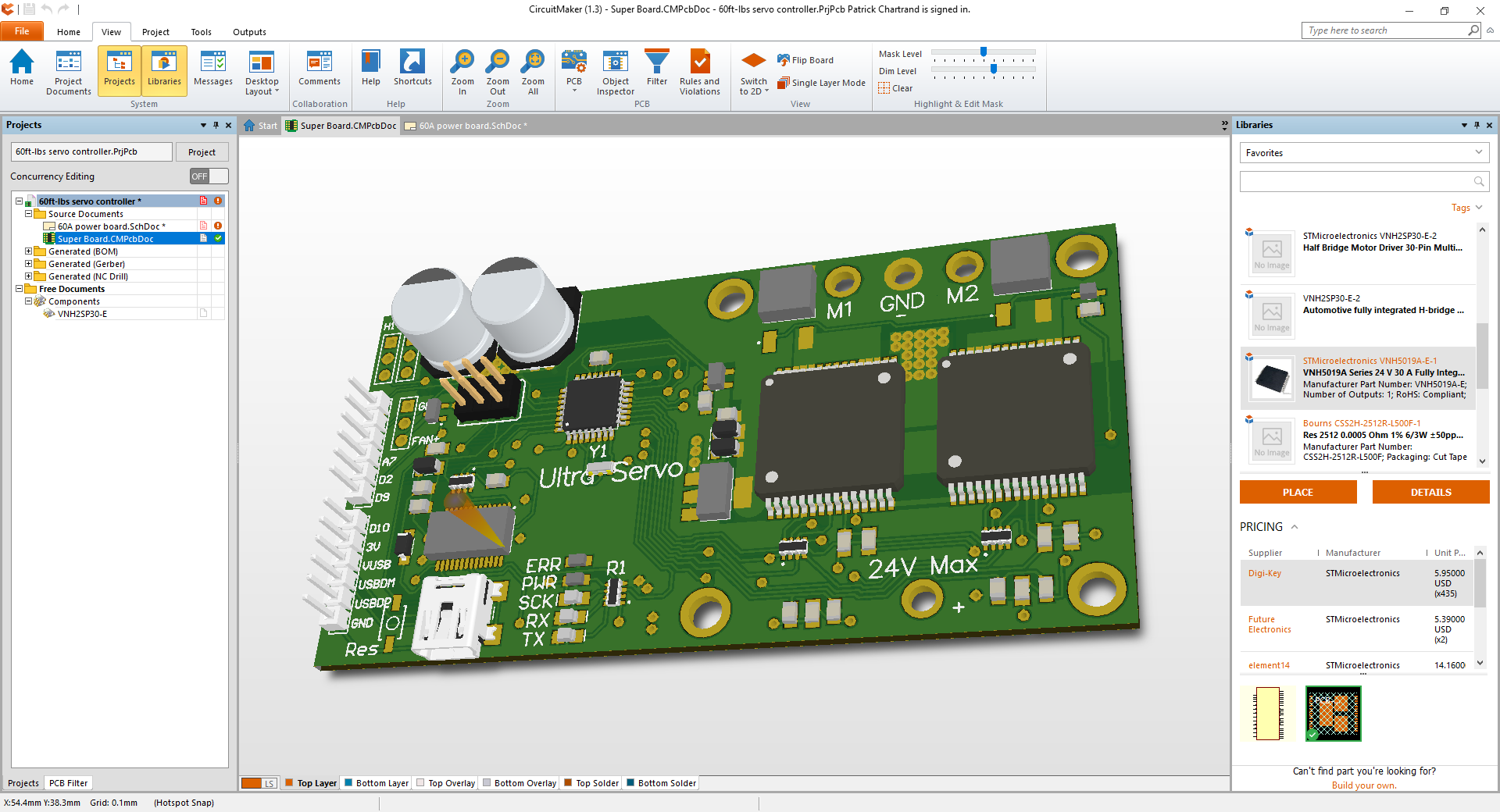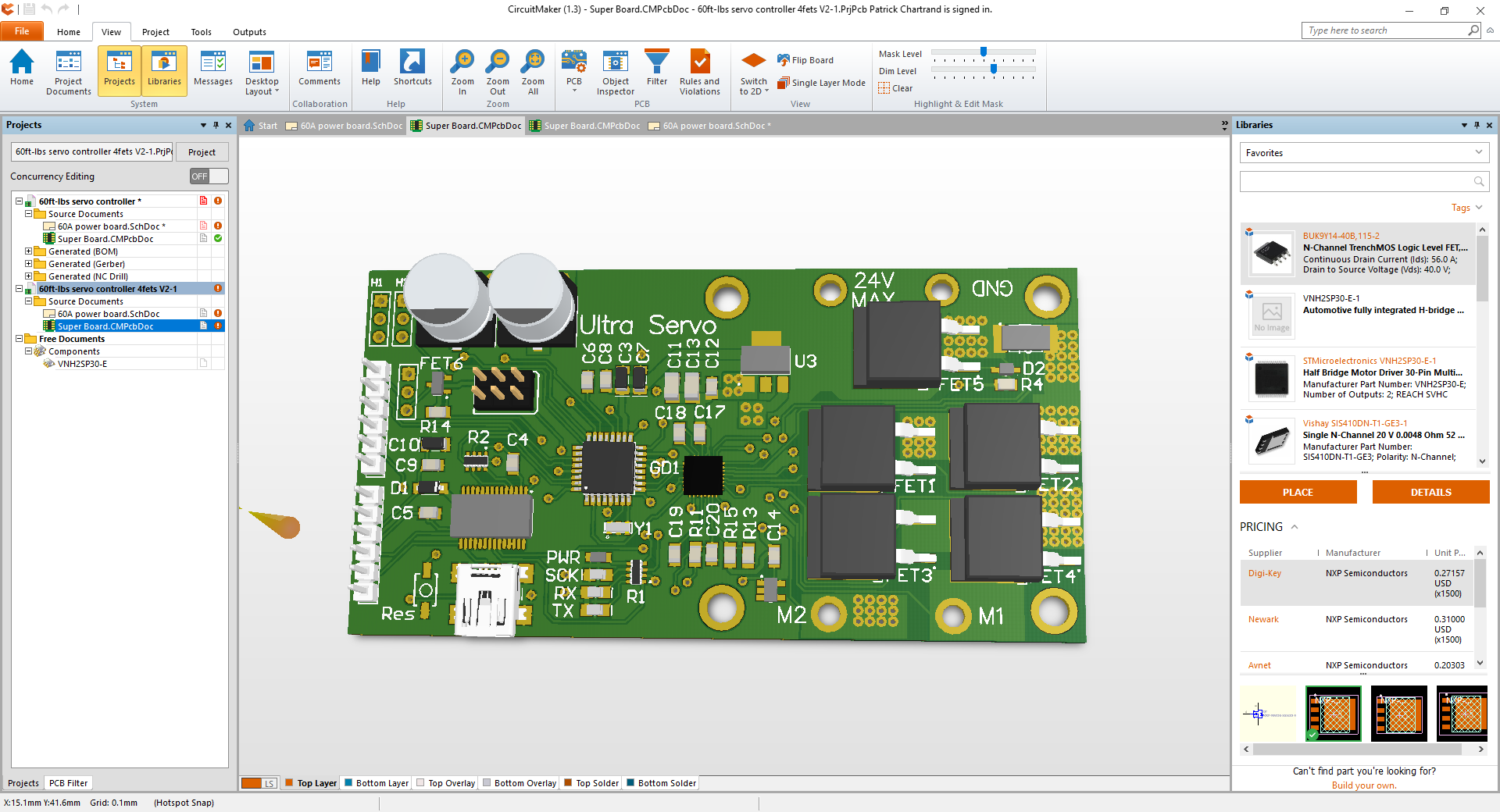Out of all the things to build this one is the most challenging for me. I have very little experience with building electronics. So I did what everyone in my situation would do and watch all the you tube on this subject. (to youtube's credit, there is lots of good content). I set out to design a brushed ESC that can handle the following power:
- 30A Continuous
- 24V max voltage
- Current sensing
- Temperature sensing
- Arduino bootloader
- Power output for case fan
- Header for users to expand upon if they want to
So with all those things on my design list, I set out to design version 1.0 of this controller. At first I used the VNH2SP30-E-1. This is a real nice chip because it dose quite a bit of the hard work for you since it is an all in one package (current sense, over temp shut off etc.). BUT when I went to buy the chip it had said that it was being discontinued.... So I switched to the VNH5019A-E. This chip is basically the same thing except it handles higher voltages and is not being discontinued. Below is a srceen shot of the final board design:
 AAAANNNNDDDD just before I sent the gerber files to the board company.... I find out that If i double up the VNH5019A-E chips, they cannot use the current sense. SO, this was quite the setback. So then I was stuck designing the 4X mosfet setup to control a board. I was a little hesitant to control the Mosfets from an Atmel chip directly (with the gate drivers applied). This would be challenging for me and any one what would want to add in some custom code without affecting the motor controller's performance. So I did some research and found the DRV8702QRHBTQ1 from Texas Instruments. This chip takes quite a bit of guesswork out of the design. The integrated shunt resistor amplifier, boost converter gate drivers and on and on... So I put it in my circuit and I am now hoping for the best. Below is a screen shot of the completed board.
AAAANNNNDDDD just before I sent the gerber files to the board company.... I find out that If i double up the VNH5019A-E chips, they cannot use the current sense. SO, this was quite the setback. So then I was stuck designing the 4X mosfet setup to control a board. I was a little hesitant to control the Mosfets from an Atmel chip directly (with the gate drivers applied). This would be challenging for me and any one what would want to add in some custom code without affecting the motor controller's performance. So I did some research and found the DRV8702QRHBTQ1 from Texas Instruments. This chip takes quite a bit of guesswork out of the design. The integrated shunt resistor amplifier, boost converter gate drivers and on and on... So I put it in my circuit and I am now hoping for the best. Below is a screen shot of the completed board.  With all of the design criteria met, I sent the Gerber files to the board manufacture and ordered all the components.
With all of the design criteria met, I sent the Gerber files to the board manufacture and ordered all the components. Soldering the board was real easy because I made an Arduino controlled toaster oven to reflow the solder. My first board went well except for the fact that I oriented the micro controller the wrong way and the pins for the motor controller chip had some shorts in it because I did not position it close enough. So I then proceed to make another board to correct all my mistakes. With a now freshly solderd board, I flashed the arduino boot loader (real impressed that it worked first shot) and then procedded to connect the battery..... The smoke came out of the board.... I put the leads on reverse polarity. this forced me to go back to the spread sheet of the chip and then I found some other design problems that could let the smoke out. I then assembled a third (3) board this time I will power it up with a power supply (ordered it last week) as to limit the current. I also bypassed the reverse polarity mosfet as it does not do anyting right now AND it may cause another unforseen problem. So whenever I get the power supply I will contunue to trouble shoot the board. Here is a picture of the latest board build complete with bypass wire instead of a mosfet.

 patchartrand
patchartrand
Discussions
Become a Hackaday.io Member
Create an account to leave a comment. Already have an account? Log In.
Well I obviously did not update anything in quite some time. I have done a major revision on the board to put better mosfets because the ones in the pictures were definitely not the best for the job. I am programming the servo right now but I am having issues getting good speed readings with angle sensor. So it looks like there will be a 3rd and final revision soon enough to bundle all the changes in a nice package. Thanks for the interest!
Are you sure? yes | no
Wow! How did it work out?
Are you sure? yes | no